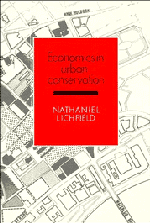Book contents
- Frontmatter
- Contents
- List of diagrams, tables and plans
- Preface
- Acknowledgements
- Introduction
- Part I Planning and management in the conservation of the urban system
- Part II Conservation of the cultural built heritage
- Part III Economics in urban conservation
- Part IV Selected tools of economic analysis for project evaluation
- 13 Financial impact: financial analysis
- 14 Economic impact: social cost benefit analysis
- 15 Community impact: community impact analysis
- Part V Case studies in the economics of conservation of the CBH
- Notes
- Bibliography
- Index
14 - Economic impact: social cost benefit analysis
Published online by Cambridge University Press: 10 November 2010
- Frontmatter
- Contents
- List of diagrams, tables and plans
- Preface
- Acknowledgements
- Introduction
- Part I Planning and management in the conservation of the urban system
- Part II Conservation of the cultural built heritage
- Part III Economics in urban conservation
- Part IV Selected tools of economic analysis for project evaluation
- 13 Financial impact: financial analysis
- 14 Economic impact: social cost benefit analysis
- 15 Community impact: community impact analysis
- Part V Case studies in the economics of conservation of the CBH
- Notes
- Bibliography
- Index
Summary
Context
In tracing through the economic decisions in the life cycle of the cultural built heritage (8.3) we saw that while heritage quality was intimately associated with the property, it could not be equated with the value of the property itself; it is one of its attributes. We therefore pursued the question: how can such heritage quality be valued? (Chapter 10). This question is of more than just academic interest for we also saw that in conservation as in economic life generally it is necessary for government to seek value for money in the use of resources seen from the national viewpoint.
This kind of search is but one of many facing government in its attempt to estimate worthwhileness and priority of projects emanating from the public rather than the private sector (highways, water, defence, etc.). In this they find, by definition, they need to address the question from the viewpoint of society as a whole, rather than the market-place. For example, in relation to a project involving rehabilitation or redevelopment, it would be legitimate to take account of such factors as rehabilitation being more labour and less capital intensive than redevelopment, and thereby saving energy and producing more employment. Given this it is found that the method of financial analysis (Chapter 13) is not adequate for the purpose. The reasons are varied. By definition public sector goods and services are often not exchanged in the market (schools, roads or amenity open space) and thus have no market price as a basis for estimating return or benefit, so that surrogate methods of value measurement need to be found (10.5–6).
- Type
- Chapter
- Information
- Economics in Urban Conservation , pp. 240 - 248Publisher: Cambridge University PressPrint publication year: 1989



